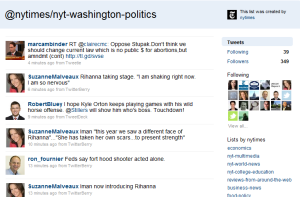This was originally posted at Mediaite. And it was also quoted in The Nation, NPR, and Politico.
“Since Sunday shows never really appealed to 20-year-olds, Thompson thinks that trying to skew younger or add new technology and graphics isn’t likely to work. “Even before cable and the Internet, you wouldn’t have gotten younger viewers,” Thompson said.”
— from “Will the Sunday shows ever change?” Politico, January 9, 2010.
A debate has been raging online about the Sunday morning political talk shows, one of the venerated old institutions in American political discourse. It was started by Jay Rosen of NYU, who tweeted that maybe Sunday talk shows should fact check everything their guests say on Sundays and run it online every Wednesday.
Today, Politico’s Michael Calderone ran a thoughtful piece on whether Sunday shows will ever change, including commentary from several media personalities. They all agreed on one thing: the Sunday show format has changed very little over the years, and has done almost nothing to adapt to the new media age that we now live in. And as such, their audience is shrinking. Their guests are largely older white males and Washington insiders, their show formats haven’t changed since they were first started, and they rarely focus on issues that most Americans care about. They’re Beltway shows that appeal only to Beltway audiences.
What troubled me the most was a quote in Calderone’s piece from Robert Thompson, a professor at Syracuse, who argued that the case for modernizing Sunday shows wasn’t that relevant because young people wouldn’t care enough to watch the shows anyway.
I stopped reading right there. I am 21 years old and have been watching Sunday talk shows for as long as I can remember, thanks to a very politically active father. And yeah, that puts me in that tiny category of political junkies who will watch Sunday shows no matter what. But as a 21-year-old I resent having my entire generation casually brushed off as uninterested in Sunday morning talk shows. Perhaps my cohorts would tune in every Sunday if they felt like these shows catered to them and spoke on the issues they care about. We are a very politically active generation, and we proved that in the 2008 election. So it’s not that we’re not interested – the problem is that the networks are failing to adapt and provide programming that appeals to and informs the masses.
I fully believe that the Sunday morning talk shows need a new media makeover, and I have a handful of ideas for how they can do so. I admit that I know absolutely nothing about what goes into the making of a political talk show. But what I do know is that my generation wants transparency, participation, and engagement in their political process – and their news. So here are my suggestions on how the Sunday shows might undertake a new media makeover that could finally usher them into the year 2010:
Take Questions From Twitter, Facebook, and YouTube
We may be living in the YouTube age, but from the look of most Sunday shows you’d never know it. Remember the 2008 presidential election debates, where CNN and YouTube asked citizens to submit questions to ask of the candidates, and then featured selected video questions during the debate? Would it kill us to allow citizens to submit questions to the newsmakers and politicians on Meet The Press, Face The Nation, and This Week? Whether it’s via Facebook, Twitter, or YouTube videos, allowing citizens to ask questions would give them a connection to the shows, engage them, and allow them to play a role in setting the news agenda. And talk show hosts like David Gregory and Bob Schieffer should help facilitate that citizen-politician connection. Although David Gregory, Bob Schieffer, and George Stephanopoulos all have Twitter accounts, their level of engagement with fans is very low. Schieffer and Stephanopoulos’s Twitter accounts aren’t even really them, but are merely RSS feeds of updates from their websites.
And while we’re on the subject, the only Sunday show with a Facebook page and Twitter account is Meet The Press. And even then, their Facebook and Twitter are both used as one-way, broadcast mediums only. The MTP Facebook page is used solely to push out promotional content for each week’s show, and they receive little response from Facebook users. But what if instead they posted a status update asking citizens: what do you want to ask Janet Napolitano on Meet The Press next Sunday? What if there was a chance David Gregory would actually ask your question to Napolitano on air? I guarantee you citizens of all ages and all backgrounds would start paying more attention if they felt like the networks were paying attention to them.
Continue reading the rest at Mediaite.





You must be logged in to post a comment.